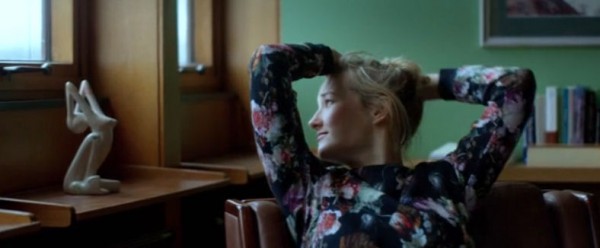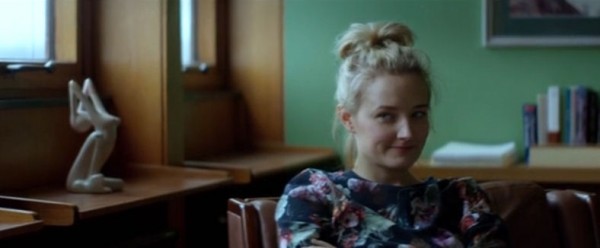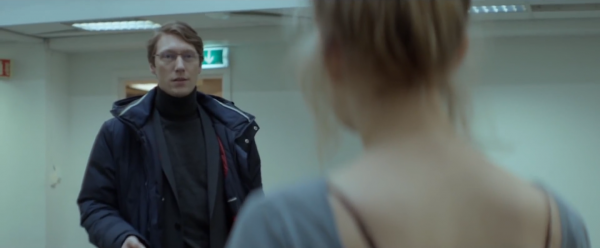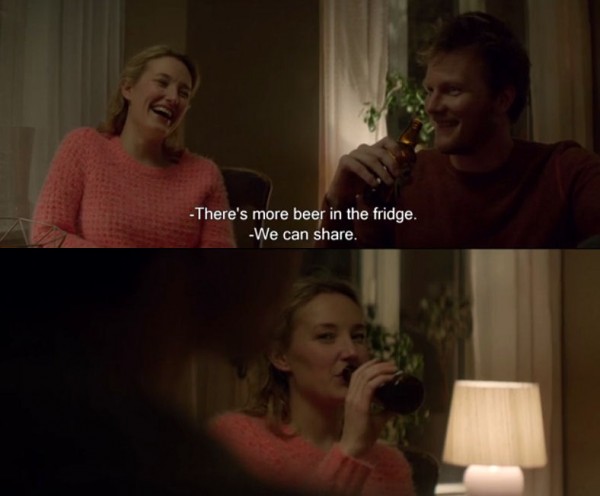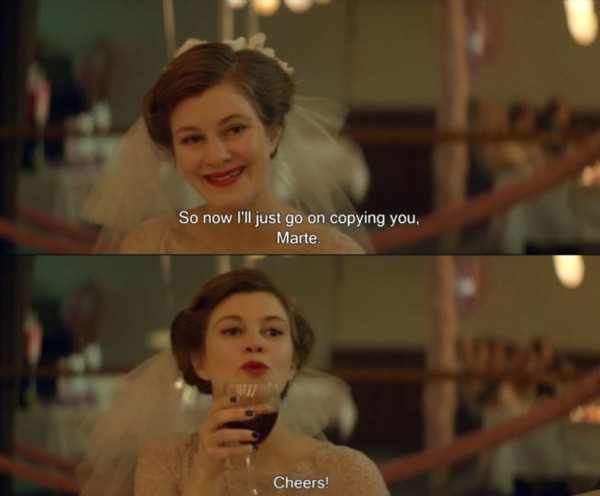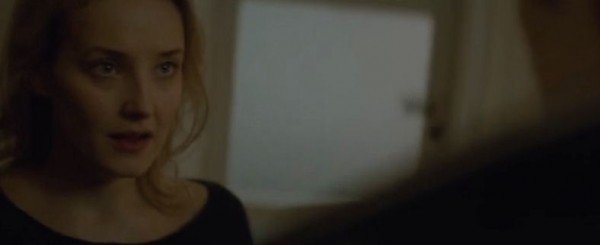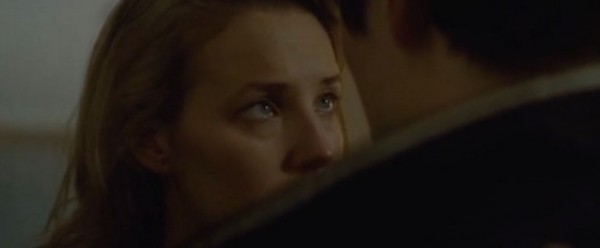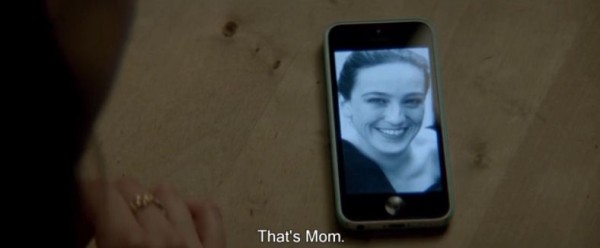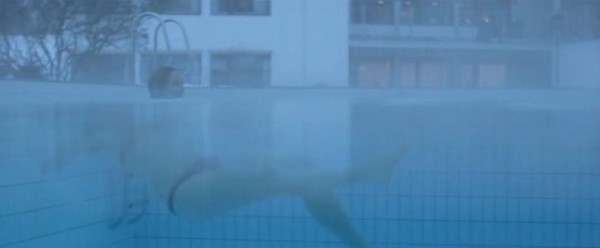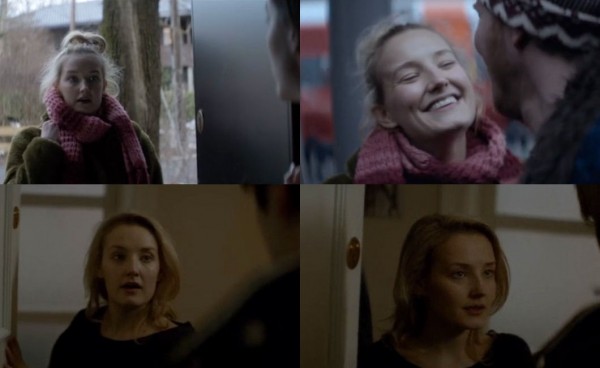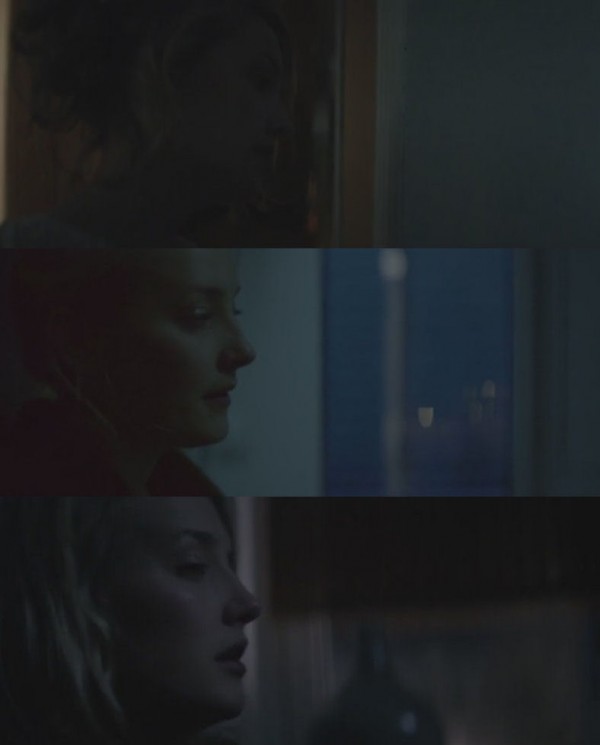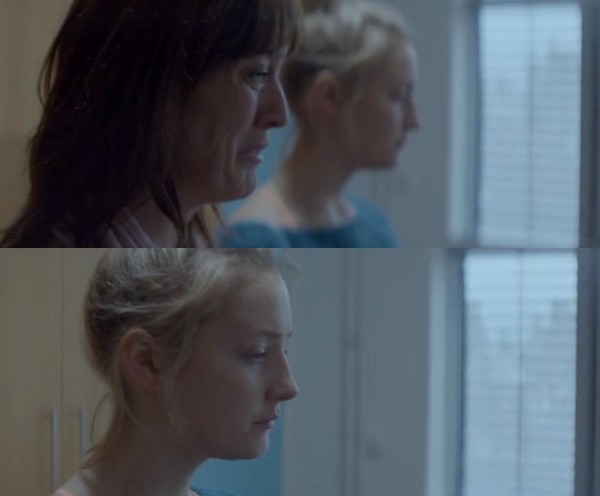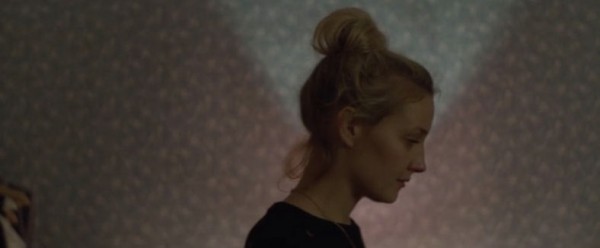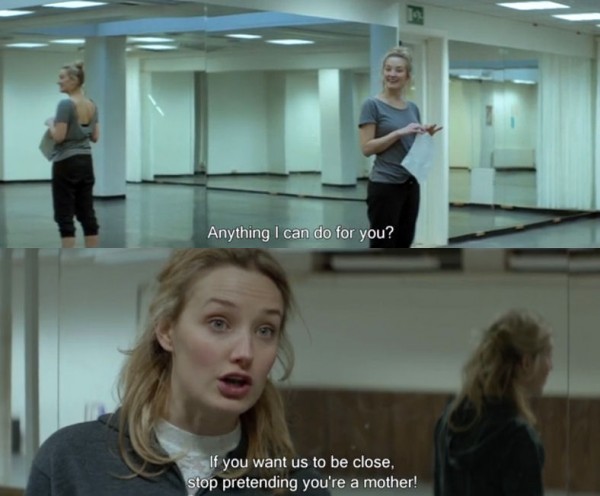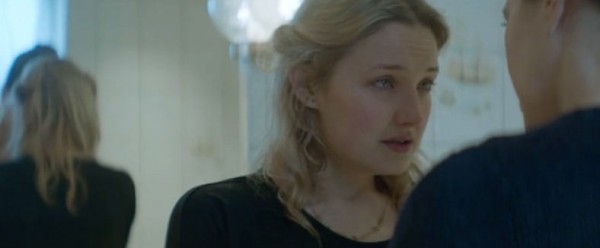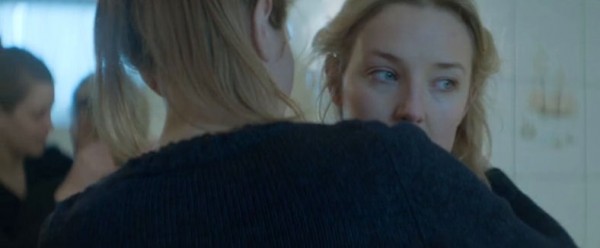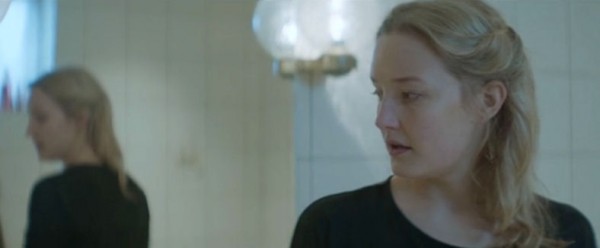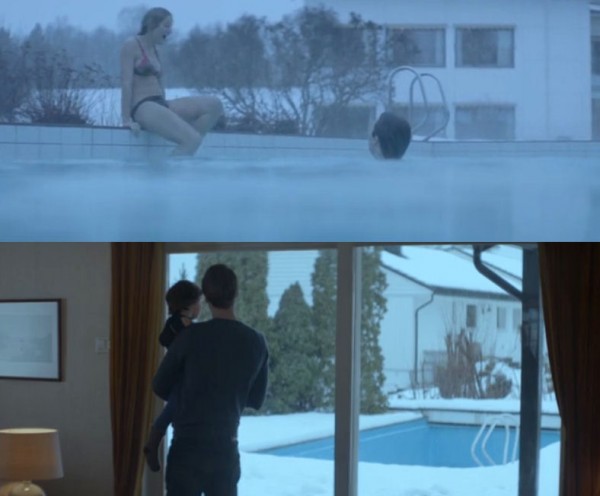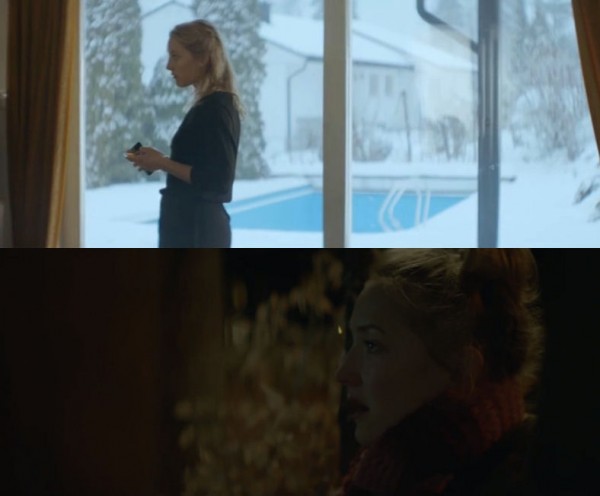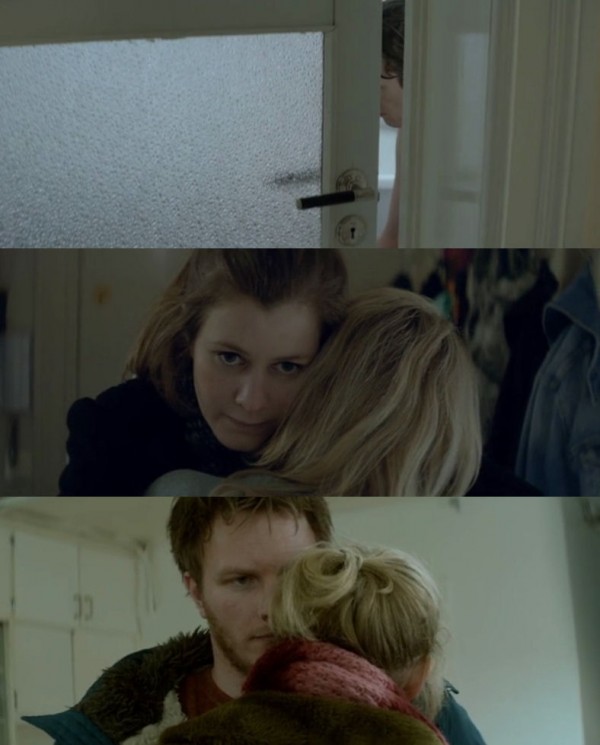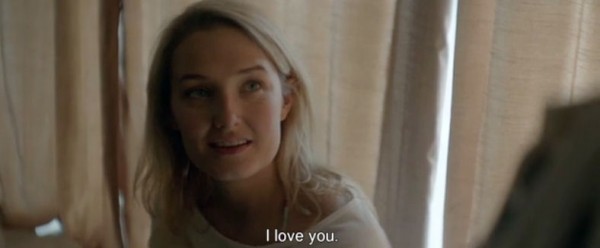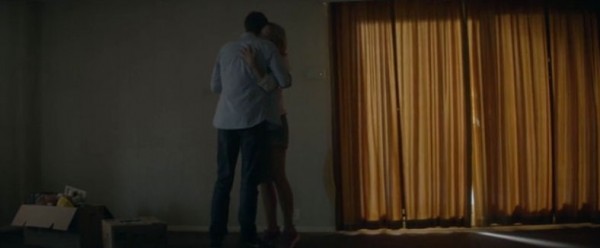
Desperate connections: An analysis of Anne Sewitsky’s Homesick (2015)
All Norwegian feature films made for theatrical release are analysed as an ongoing project on the Norwegian edition of Montages (the 2015 analyses are now collected in a hardcover book). This is an example of one of the analyses, about Anne Sewitsky‘s film Homesick. It was also one of three films discussed in a recent international seminar at Tromsø International Film Festival. The others were Louder Than Bombs (see an English-language article about it here) by Joachim Trier and the documentary Brothers by Aslaug Holm. The panel consisted of David Thomson, Dana Stevens and Christine Masson. The discussion was streamed live here.
Most screen shots from Homesick cited in this article are from a screener made available for Montages by the film’s production company. The article contains spoilers.
*
Literature tries to the explain the human being, films show us in all our confusion. The realist novel often provides full insight into the characters’ mind. In films our knowledge of their inner lives is limited. Good directors turn this to the film medium’s advantage. Their works attain an enigmatic dimension where we ourselves, like towards our fellow beings in real life, must interpret the characters’ facial expressions and body language – not seldom in minute nuance – to form a picture of motivation and emotion.
Many claim cinema to be a passive medium since the images we must create ourselves in literature here are already made for us. This is far from the truth. The very nature of cinema encourages us to participate, be an active interpreter, and films may become a study in human behaviour. Furthermore, cinema is as much a lyrical and metaphorical as a storytelling medium. Images are doubtless ready-made, but what they imply is another matter. Good filmmakers are not satisfied with merely telling a story, and the art form of cinema provides unique opportunities to sneak in symbols and patterns that augment, deepen or unify the work.
This analysis shall examine the structure of Anne Sewitsky‘s third feature film Homesick (“De nærmeste”, 2015). This will also provide a foundation for interpreting causal relationships and character motivations in a work that in many ways appear suggestive, almost inscrutable. Freeze frames from the film will play a prominent part, most heavily in the last third. But let me first clarify my own general appreciation of the film.
It is not difficult to join the almost universal acclaim from Norwegian reviews. The feature film debut of Ine Wilmann is blistering, in its fearlessness, range, emotional rawness and believability. Furthermore, Sewitsky does a very bold move by presenting a sexual relationship between half-siblings without a morally pointed finger. Instead she depicts its beginnings as a completely ordinary love relationship, and the first night they are out together is told through the mechanisms of the romance genre. Even though I interpret the final scene differently, it is sufficiently open to allow a plausible guess that the siblings’ sexual relationship will go on. Sewitsky risks that many will turn against the film because its sexual dimension will be hard to relate to – especially the extended, nightmarish last sex scene.
One of the greatest qualities of Homesick is precisely the erotic, depicted with monomaniac, escapist intensity. Furthermore, the film brims with memorable scenes: The dance between the female friends early in the story. The two bathroom scenes, respectively heart-wrenching and brutal. The shock when the fatally ill father wakes up, tormented by runaway fear. The insane situation when the protagonist suddenly bangs her head against the table. The dance performance with the children, which becomes a study in wistfulness and doubled emotion. Many scenes appear traditional, but the sureness in tone and execution, and Sewitsky’s ability as a director of actors, make them shine.
There are only two negatives of importance to mention: it seems to be some technical problems early in the film, causing some images (for example the establishing shot of the railway station where the protagonist bids goodbye to her boyfriend) to be somewhat out of focus. This has not really diminished my own experience, but one wonders why such imperfection occurs. There are also a small avalanche of assorted bits of exposition in the backyard during the wedding, in a way that feels forced and unmusical, especially since the rest of the film is so reticent.
Homesick fells unforced, organic and “breathing”, but is also cerebral and thought-out. The latter is well hidden, however. The film primarily plays on the unspoken. Dialogues are marked by pauses and silent tensions between characters. Most films increase their pace towards a climax, but in Sewitsky the pauses just grow longer and more pregnant. Little information is provided about the characters’ background and past, and their motivations for acting as they do must primarily be read between the lines.
Copying
The very first visual information in Homesick shows the protagonist Charlotte (Ine Wilmann) in a position where she is copying the posture of a statuette at her psychologist’s office:
Then she looks towards the statuette and gives pause:
She ends up with a half resigned, half knowing smile, as if she realises that she almost automatically copies her surroundings:
Charlotte lacks an own identity, and this becomes an important theme of the film. The statuette can be taken as a symbol of her powerlessness against this.
Copying and imitation are recurring motifs in Homesick. During the wedding party early in the film, Charlotte says in the speech to her best friend Marte (Silje Storstein): “I am going to continue copying you”. It is already going on at full throttle: during the party Charlotte wears the same type of dress as the bride and both have flowers in their hair. Later, she stays in a hotel outside town together with her half-brother Henrik (Simon J. Berger), whom she has just met for the first time and started a sexual relationship with. Here she continues copying Marte. First she pulls the waiter’s leg, claiming that the siblings have just gotten married. She has also nicked a beautiful necklace Marte got as a wedding present, and Henrik follows up the joke by giving it to her as a “wedding present”. The copying also takes place at work: Charlotte acts like a child together with the small children at the dancing school, on the other hand she teaches them to dance, copying her, and through their identical moves, also each other.
Charlotte and Marte are soulmates. This is visually established in the early scene at work, where they dance “Cats” together – here almost every shot emphasises how they are harmoniously copying each other’s movements. This incident forms a counterpart to the later sex scenes between Charlotte and Henrik, and the film’s trajectory is marked by how Charlotte will substitute one soulmate with another. (Is it a coincidence that the “Cats” dance is tightly connected to Henrik’s introduction in the film, by happening right after his unexpected visit at the school?)
In this dance scene the images truly say more than a thousand words. In concentrated and unified form – better than any detailed “back story” – the scene demonstrates that the friends are on a perfectly identical wavelength. Thus the film sneaks in vital information into a situation that is outwardly only charming, warm and aesthethical. Incidentally, this is a textbook example of a scene whose value is heightened on repeated viewings – until it becomes one of the most moving situations in Homesick, since our later experience will be coloured by wistful certainty of the coming scene with the bitter schism between the friends. The mutual pollination between the two scenes is strengthened by the film music’s use (copying!) of the same melancholy synth theme. Also during the wedding, via a briefer glimpse, the same harmony between the friends is emphasised, when they throw themselves into a wild party dance.
Identity and character fusion
Charlotte (irritated): … now you are my mother.
Psychologist: But I’m in fact not your mother.
Charlotte: No, I know you aren’t. But she’s exactly like that. She insists that she would like to be here, but then she doesn’t really want to.
The “Cats” scene is not only copying, but some sort of fusion between the two persons. The fusion motif is reflected in a curious use of language in Homesick. In her wedding speech Charlotte says that when she saw Marte for the first time, she wanted to be her. She tells the irritating psychologist that “now you are my mother”, even though the behaviour of her somewhat disinterested conversation partner is merely similar. (Here Charlotte may simply be projecting her own difficult mother relationship onto the older, slightly maternal psychologist, thus fusing them.) Soon she is given an exercise where she shall try to see herself as a baby through her mother’s gaze, again a fusion of two persons.
The new soulmates, Charlotte and Henrik, try to become as one through sexual activity, and especially their nightmarish fourth sex scene bears witness of a desperate, self-destructive urge for fusion. Furthermore, the text message that Charlotte sends to Henrik, “I want to have you inside me”, is on the surface clearly sexual, but also a metaphor of the need to share the same body.
As regards the theft of Marte’s necklace, the editing is interesting. We do not see Charlotte’s face but only the body parts performing the action. Is the theft not a conscious act, but something that happens “by its own volition”? The wedding party takes place at the dancing school, in fact inside the very same room that is Charlotte’s arena of achievement, where she teaches the children and danced “Cats” with Marte. Is it the urge to become one with her friend that makes Charlotte take the jewellery?

Charlotte’s decisive break-up with Henrik is immediately followed by the dance performance for which Charlotte and the children have trained for so long. In ironic contrast to the failed fusion with Henrik, here she is two people in the same body – inwardly extremely unhappy, outwardly demonstratively happy. The studiously mechanical pop music they dance to (with the fitting title Out of Yourself by Truls) and the dancing’s marionettelike nature strengthen the feeling that Charlotte “is just going through the motions”.
During the wedding Marte mentions “Swan Lake” and the white and black swan, two diametrically opposed personalities in the same body. (Precisely “Swan Lake” has been the basis for a dance the children have learnt earlier in the film, which is the reason that Marte is referring to this ballet.) Here Marte wears a black coat over her white wedding dress, and through the film she is almost always dressed in black. Marte is never depicted as a split personality, however, so the purpose of the reference seems rather to put allusions into play that can thematically work together with Homesick. Charlotte speaks of an eagle to the children – a change from the original ballet’s owl – and just afterwards Henrik is introduced in the film, as he arrives at the dancing school, in dark clothes. Considering all of this, it is impossible not to think about Darren Aronofsky‘s Black Swan (2010), where a character with a “split personality”, with a problematic relationship to her mother, is training at premises resembling Charlotte’s dancing school. Furthermore, during the dance performance everyone involved is dressed out and made up as black mice, recalling the black swan (and possibly indirectly the “Cats” dance). In this way, Marte, the former soulmate, is also sneaked into that scene.
The issues of identity and a yearning for this are reflected in the many situations when the siblings pretend to be someone they are not. Towards Marte, Charlotte is fooling around with a towel as a kerchief, pretending not only to be a gypsy but also The Girl with a Pearl Earring. During the dance Charlotte and the children are dressed up as mice, and she is pretending to be happy. Henrik seems especially apt at such role play. (And he is an excellent actor, for when Charlotte’s boyfriend Dag [Oddgeir Thune] unexpectedly returns from touring, Henrik appears to be in a good mood when the three of them are together, even though he is furious with his rival.)
The first evening the siblings are out together, as the most natural thing in the world Henrik sneaks themselves into an afterparty, claiming that they are a couple from the Swedish town of Strömstad. Inspired by Henrik’s general boldness, Charlotte claims to the hotel waiter that they are newly married. All this role playing reaches a boundary-crossing dimension as the siblings enter the roles of lovers and, at a certain point, members of a nuclear family.
Family
Psychologist: What about your father?
Charlotte: He drank – simply.
Psychologist (about her mother): And now you’re going to punish her?
Charlotte: Yes.

In the universe of Charlotte’s mother (Anneke von der Lippe), identity and mastery are connected to achievements. Both times Charlotte and her mother are together by the father’s sickbed, the daughter is virtually assaulted by reports of her mother’s academic feats, delivered with a goofily proud smile, bordering on the unhinged: “I got an ‘A’ at the exams – not bad, besides holding a full job!” (By the way, here are the Western TV series and novel she is babbling about.) She is constantly hunting for praise and confirmation of her own excellence, and this seems to be her primary way of relating to her daughter, who on the other side can only offer confused lip service. When Charlotte’s father is dead, the after-funeral gathering becomes to her mother a display window for her abilities as a singer. Even though she is happy about finally meeting Henrik and her grandson Oscar, we get the impression that this is most of all just another wonderful event in her life. (The importance of family in Homesick also resonates in the necklace that seals the “marriage” between Charlotte and Henrik, which was once a present from a grandfather to a grandmother, according to Marte’s Mexican husband.)
Charlotte’s own sense of achievement is connected to the dancing school and being with its children – as some kind of substitute mother, but a good mother in contrast to her own. It is striking how Charlotte keeps this part of her life away from her mother. The latter does not even know about Charlotte’s soon-to-come dance performance. Charlotte becomes furious when she finally turns up at the school, and the situation leads to a showdown about her lack of motherly love. This is an echo of how Henrik earlier turned up at the same place, and then it was Henrik’s turn to become angry, since Charlotte pretended not knowing who he was – she did not acknowledge him, like his mother did not acknowledge him leaving him behind.
Homesick is soaked in such lies and concealments, almost all of which are connected to family: the mother’s monstrous lie to Charlotte that it was Henrik’s father who divorced her, not the mother who left her child. Charlotte has not mentioned to Marte that Henrik has moved to Oslo. (As a sign of their intimate relationship, Marte is surprised, and almost reproachful, over having been kept in the dark.) On her own hand, Marte has held back her plans to become pregnant, and later that she has actually become so. Charlotte’s mother lies, perhaps so well that she believes it herself, that it is Charlotte who has asked her to begin singing. And has Charlotte kept quiet about having a boyfriend, taking Henrik by surprise when he suddenly turns up?
The mother is also shut out of Charlotte’s private sphere, which consists of Marte’s family, who have “adopted” her. After the funeral the mother hardly recognises Marte’s mother, who on her own hand has become such a central person in Charlotte’s life. In a symbolic foreshadowing of the incestuous relationship with Henrik, Charlotte has entered a romantic relationship with the son in her “adopted family”, her own “brother”, and during the wedding Marte is ill at ease that her “sister” Charlotte is making out with her brother. The incest foreshadowing is strengthened by the fact that Charlotte’s own half-brother is mentioned in the film for the first time in the same breath as Marte’s complaining about the kissing. (Later, Charlotte is kissing her boyfriend again, this time in front of Henrik, and now it is Charlotte’s turn to be embarrassed.)
There are significant similarities between Charlotte and her mother. Outwardly, both are lively, extroverted and energetic. In their confrontation scene the mother talks about painful matters, but with an automatic smile, mirroring Charlotte’s own defence mechanism. Marte complains that Charlotte is “too much” – exactly the same wording as when Charlotte describes her mother to Henrik’s family. It is also conspicuous that Marte, with her large and warm eyes, looks quite motherly, and sometimes Marte is like a mother comforting a small child, like in the bathroom scene where Charlotte breaks down.
Finally, from the psychologist conversation it is easy to get an impression that Charlotte has a difficult relationship to both parents, since she dismisses her father as an alcoholic. Like her mother also he thus failed Charlotte. But the sequence of the dialogue rather suggests that Charlotte’s “punishment” of her mother, at least partly, comes as a response to her father’s drunkenness. Was it the mother who drove him to drinking? In reality Charlotte seems to be doting towards the father. She is constantly visiting him at the hospital – the nurse is recognising her – and seems sincerely distraught about his terrible anxiety attack, and she brings Henrik along to “say hello” to him. She is unable to cry when he is dead, but this is probably due to the fact that her mother’s overwhelming “abilities” also include emotional reactions: she cries so much that Charlotte is again overshadowed.
The intruder motif
Charlotte’s mother says: “You’re messing around with things that don’t concern you,” when Charlotte says that she has been seeing Henrik. Family is also connected to another major strand of Homesick, the intruder motif: both the mother and Henrik unexpectedly intrude at the dancing school, Charlotte’s arena of achievement. Charlotte calls on Henrik and is invited into the house of his family, something that leads to the disintegration of that family. (Henrik’s wife says: “May I give you something” – she means “serve you something”, but the line gets double meaning since it is Henrik who she finally “gives” away.)
It is also revealed that Henrik as an 18-year-old went to Norway and rang the doorbell of Charlotte’s family house, where he also met his half-sister at the door. He did not reveal his identity, but became jealous of her and felt that it was in this house he should have lived. When the siblings are on the town, they intrude on another group of people and join their afterparty. Furthermore, Henrik first intrudes on the relationship between Charlotte and her boyfriend, and then simply moves into her apartment. And when the boyfriend unexpectedly returns, he becomes in turn an intruder on their relationship.
According to Marte, Charlotte has forced herself on her, leading to being “adopted” by Marte’s family. When things get difficult with Henrik and she gravitates back to Marte for advice (“I don’t know what to do”), she is intruding in a domestic situation – which ends by her being pushed out of Marte’s life. She says: “I can’t stand it any more. You’re too much. You suck out all my energy. You just force yourself on me. You force yourself on everyone. It is one thing that we have taken you into our family, but you’re not one of us. You’re not.”
Homesick has been criticised for a lack of preparation for this turning point, so what happens here? At this point, the two friends have already started to drift apart. Charlotte spends a lot of time with Henrik, while Marte is worried about her husband being unable to get his education approved in Norway. In her new situation as married and pregnant, she has no longer so much in common with Charlotte, a friendship based on fun and playfulness. During the showdown Marte also becomes irritated by Charlotte questioning whether she knows what she is doing now she is to become a mother. (Charlotte is probably anxious that her friend shall grow even more remote, but the question may equally well spring from her own difficult childhood, and directly from her mother’s recent outburst that she was only 19 and too young when Henrik was born).
What is worse, though, is that Marte now strongly suspects that Charlotte not only has something incestuous going with Henrik, but also that she is unfaithful to her boyfriend, Marte’s own brother. (We will get back to this here.) Moreover, Charlotte’s behaviour becomes increasingly strange, with for example the theft of the necklace and her bizarre reaction when it is discovered. In the showdown, Marte is using her immediate irritation about Charlotte’s questioning of her pregnancy as a pretext: it is time to push Charlotte away for good, and this is done most efficiently by attacking Charlotte at her weak point, namely the urge to be part of Marte’s family.
The film itself provides quite different signals than Charlotte merely having forced herself on everyone and actually being quite popular. At a point where the friends have started to drift apart, Marte’s mother says: “Shouldn’t you and I and Marte have dinner together soon. We miss you!” The only suggestion of discontent from Marte – in the film’s early parts – comes when Charlotte is about to begin her wedding speech, and Marte’s expression reveal a certain tension about what her unpredictable friend may say. The speech is constantly teetering on the brink of real embarrassment – as an audience, we flinch and prepare for scandal – but Marte seems to be touched by her friend’s honesty about the innermost emotions towards her and her family. At the end they blow kisses towards each other (in one more instance of copying), and Marte has tears in her eyes.
In the very first shots of Marte, as Charlotte arrives at the dancing school after the psychologist scene, Marte greets her with wild enthusiasm. Marte regularly proves great interest in Charlotte, and after her friend has become more and more absent after having met Henrik, Marte reaches out to her with a “How are you really?”. As we have seen, the “Cats” dance also proves how close they are.
Inner conflict
Psychologist: For you don’t want her to be too close to you?
Charlotte: No.
Psychologist: But you want her to be close to you.
Charlotte: Yes (hesitates) – no. No, that I don’t want.
Psychologist: But you want to have someone close to you.
Charlotte (resigned): Yes.
The dialogue with the psychologist speaks volumes about Charlotte’s strongly split nature. She both wants and does not want to leave the appointment. She both wants and does not want to be close to her mother. When she says to Henrik towards the end of the film: “Don’t leave me,” we get the impression that it also means: “Leave me”. Charlotte also uses her face as a shield: she seems almost unable to say anything without an accompanying smile or giggle, as if wanting to take the edge of everything. This has paradoxical results in the moving scene where she calls on Henrik to seek comfort, when even the news of her father’s death is followed by an automatic smile.
Charlotte’s state of inner conflict is well expressed when Marte’s “How are you really,” is met by: “I just get a little…afraid. Or it is the first time I really feel that everything…is in place.” Both the first and third sex scene with Henrik intermittently shows her face being turned away, as if she is outside herself while she simultaneously enjoys it. (It also may be some sort of automatic watchfulness, looking around to see if someone observes their taboo-breaking activity.) After the second, very harmonic sex scene she nevertheless looks at herself in the mirror with a scared expression. The fourth sex scene is totally insane, alternating between what almost looks like wrestling and senseless copulation.
Charlotte is digging her own grave: she gives away the fact that she wears Marte’s necklace af the funeral gathering, when she washes herself and it becomes visible. Just before, the anxious Marte has asked her what kind of relationship she really has with Henrik. As an attempt to change the subject, Charlotte says she feels dirty, which is fitting since the necklace, as the “wedding present”, represents her incestuous pact with Henrik. Towards the end of the film she lets her phone lie around, enabling her boyfriend to confirm his suspicions, as he discovers a sexual text message to Henrik. In these situations it is as if she is saying to the world: Stop me!
The heart-wrenching bathroom scene shows Ine Wilmann at her most virtuosic and versatile, playing out a wide range of contradictory emotions in ultra-rapid succession. At one point Charlotte embraces the comforting friend, then she pushes Marte away. Does she look at herself as such an unworthy person that she does not deserve comfort? Has she become so confused and unable to trust her own impulses, that she fears any intimacy might suddenly develop into something sexual between the female friends, in line with her explosive experiences with Henrik?
On his hand, Henrik both wants and does not want to have contact with Charlotte: he leaves her in anger at the dancing school with the message that she is to keep away from him, but accepts her into his home without protest when she turns up at his house. But after having let Charlotte wait for a long time as he finishes things at work, he says, with almost sadistic indifference, that it suits him best after all if they do not go out that night. When he realises how disappointed she gets – even though she attempts to take it in her stride – he recognises his own past disappointment of having been rejected, and changes his mind.
The same pattern is at play in the run-up to the first sex scene:
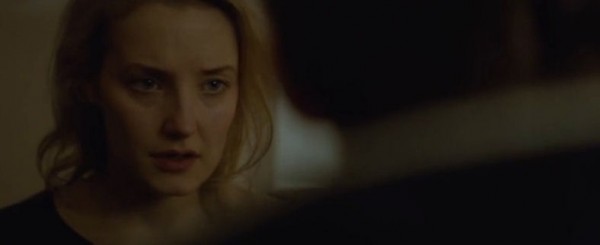
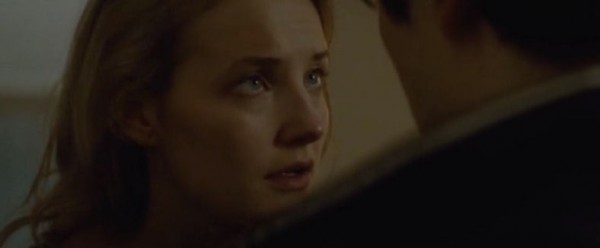
Henrik dominates the relationship and enjoys being in control. He becomes furious when Charlotte pushes him under in the swimming pool (and forbids her doing a somersault, something he deems dangerous). It is he who orders her to hit her head against the table to get away from the deadly boring bureaucrat afterparty. It is he who is testing out her limits: “I never thought you’d do it,” he says afterwards. The suggestion of postponing their beer might be another test, to read a possible disappointment in her face, to gauge how much he means to her. The kiss might be a new test.
Their common willingness to break boundaries becomes the foundation of their wild fascination for each other. The ice is broken precisely through her bizarre head-banging during the afterparty. Suddenly they experience a fantastic rapport, find out that they are soulmates, and fall in love, just like regular people not being in family. In the scene that ends their night out, they have a late meal at his place. Here they stop and just remain gazing at each other (while sacral film music starts). This is the exact moment they sense there is something more between them than just friendship and love between siblings. (Sexual attraction between siblings who meet as adults is a known phenomenon.)
At this moment they might well have kissed each other, but if Henrik’s small son wakes up and breaks the spell. (The son’s status as a family member also serves as a reminder that they themselves are brother and sister, something that lends additional meaning to the interruption.) But only temporary, for the sacral music, which marked their moment of falling in love, continues on the soundtrack while we see Charlotte in her everyday routine the next day, until Henrik turns up at her door, with powerful consequences. Probably he has been thinking about her all day, like she has about him.
The gaze of the other
Psychologist: If you close your eyes… Then you focus on seeing your mother before you. How was her first gaze on you when you were born?
Charlotte (after a long try): No, I don’t know. I don’t see anything.
Charlotte’s father suddenly wakes up at the hospital, crying violently, asking: “Where’s Mommy?” Both we and Charlotte (“She’ll come soon!”) think he means his wife. But as a consequence of the exercise at the psychologist, the incident seems to start a process in Charlotte. After her father has calmed down, the camera dwells (see the above screenshot) for a long time on her face in extreme close-up, with a special emphasis on her eyes. As if this were the first station in a process where she attempts to break free of her narrow point-of-view, she now puts herself in the place of her father – not her mother – and sees with his gaze. She looks at the world through his eyes, like a little boy shouting for his mother. His desperate outburst leads her thoughts to Henrik, who were left behind by his mother. Then there is a direct cut to a scene where she stands outside Henrik’s house. One of her first actions inside the house is showing them a picture of Henrik’s mother:
The enigmatic shots in the hospital room, that at first sight might look like pure mood-creation as well as characterisation of Charlotte’s shaken state after the outburst, have an indirect storytelling layer: they represent a decision process in Charlotte about defying Henrik’s admonition to stay away. Precisely like Sewitsky plays on the unspoken in the interaction between characters, also the causal relationships in the narrative are enigmatic, almost inscrutable. When Charlotte arrives at the house, we understand that a decision has been made, but the fact that it is actually made during the previous shots is rather obscure. (A reflection of the fact that the processes are enigmatic to Charlotte herself?) Here a concrete interpretation of the images (that we are actually meant to emphasise on Charlotte’s eyes), the realisation that the eyes are part of a strand that started at the psychologist, and the succession of the scenes become important to understand the full meaning of the film.
Here it is also tempting to draw a connection between the “door” in the window in front of which Charlotte is so scrupulously placed – where she even sits fidgeting, restlessly, as if eager to get up and walk – and the house door in the next shot. Yet another illustration of her decision-making process? Previously she has only spied on Henrik’s house from outside. Now she dares ring the bell:
After all the following events that culminate in Charlotte having sex with Henrik, we are almost immediately served another enigmatic shot of Charlotte in the hospital room. Here she has her back to the camera looking out the window, before she turns around and looks out of the frame inscrutably, probably towards her father. It is as if this new gaze at her father functions as a closure of the long stretch of the narrative that started with her previous gaze at him. This is also a comparison point: the decision to visit Henrik has led her into a completely unexpected direction. The film music serves as extra bridge-building: a piano theme starts as soon as the sexual incident is finished, binding together the aftermath of the sex scene, a shot of Charlotte showering, and then Oslo cityscapes, before the theme dies out with the close-up of her at the hospital:
Later the same pattern is repeated. When her mother turns up at the dancing school asking to see Henrik there is a confrontation. With ice-cold deliberation Charlotte pushes her away by pointing out that she has never been a mother. Metaphorically, she is repeating her father’s “Where’s Mommy?” The mother attempts, rather clumsily, to cast light on her own situation as a young mother leaving Henrik, and her lack of ability to show physical intimacy with Charlotte. The daughter nevertheless seems to take in what she says, and there is a direct cut to an intense crying scene where it is clear that many of Charlotte’s tensions are loosening up. Like in the hospital room, she is again seen in an extreme close-up concentrating on her wide-open eyes. This is a new stage in the strand that started with the exercise at the psychologist. This time she sees the world through her mother’s gaze, at Henrik and Charlotte as children, but also at her desire to see Henrik. Charlotte looks up, as if she is a small child looking up at her mother, in some sort of mutual exchange of gazes with her:
Once again there is a cut to a visiting situation. Now it is not Henrik’s house, but the mother’s house that is to be entered: Charlotte has persuaded Henrik to join her to see his mother. This is not necessarily an easy decision – if Henrik hits it off with her, Charlotte’s own relationship to Henrik might be weakened. We recall that Henrik’s wife took a similar role of intermediator upon herself, by encouraging the siblings to become friends, which finally leads to Henrik leaving her. Henrik brings his small son Oscar, and interestingly enough Henrik does not seem at all to have attachment issues to his own child. This humanises Henrik as a character, who otherwise appears rather cold, distant and almost manipulative. It is nevertheless telling how easy he leaves his wife, something he mentions almost in passing.
The visit also improves the relationship between mother and daughter – an important way station towards the budding understanding between them in the epilogue – and in a brief moment (over) we see them dance together, attuned to each other, just like in the “Cats” dance between the best friends.
Children in adult bodies
Charlotte is looking at her mother holding the grandson, but metaphorically it is Henrik or Charlotte she is holding, the children she were unable to relate to as a young person. The blending of a childlike and adult personality is a distinctive feature of Homesick, something that is related to the discussion of the fusion of identities earlier in the analysis, and the two situations where Charlotte is looking with her parents’ eyes.
Like the protagonist of Sewitsky’s debut feature Happy, Happy (“Sykt Lykkelig”, 2010), Charlotte appears like a child in an adult body. Perhaps this is the reason she enjoys herself so much among the children at the dance school (tellingly, her sole arena of achievement). This is not only evident in her childlike behaviour with the children, but also the film’s mise-en-scène. The dance performance thus crystallises Charlotte’s essence: she is the only adult among children, dressed out in the same (childish) costumes as them, performing exactly the same moves as them. Additionally, after the break-up with Henrik she is “unhappy, unhappy”, but must pretend to bubble with joy, so this incident also functions as a magnifying glass for her general personality: outwardly happy, inwardly sad.
But when the performance is over, she is left as a bystander when the “other” children are hugged by family members among the audience. (Charlotte seems to have staged the performance so that the children is to be sent out to hug spectators – an expression of her own yearning for intimacy?) Her boyfriend, earlier seen in the audience, is suddenly gone and his hug in the dressing room later is very half-hearted and ambivalent.
Marte appears as childish as Charlotte, and is introduced in an extraordinarily agitated way (over). There is a direct cut to a shot of Charlotte creeping along the floor, and we expect Marte to be still included in the scene, but as the camera moves it is revealed that Charlotte is instead among the “real” children – a film-linguistic “equal sign” between adult (Marte) and child. In a further mirroring of the child motif, Charlotte’s musician boyfriend works in a kindergarten when not having enough gigs. In a parallel to Charlotte’s dancing, it is emphasised that he is playing football (as the only adult) with the children.
Charlotte is often acting childishly, perhaps most of all when she insists riding on the automatic transportation vehicles at the hospital. During their painful confrontation scene Charlotte and Henrik at first fight like children: they pinch each other and pull the other’s hair, and Charlotte says with childlike intensity: “I hate you”. During the hotel stay they “play” themselves into sexual matters by pretending to be newly married. Like naughty children they grin at each other, and in a telling simultaneous action, the adult side of Charlotte’s personality puts on lip gloss.
In the swimming pool the refraction in the water makes their bodies look like a fusion between a child and an adult:
Through most of the film Charlotte’s hairdo is shaped in a way that makes her look childish and immature. The very first time we see her with loose hair, however, is just before the first sex scene with Henrik, where she suddenly appears adult and sexy:
The next time she is seen with loose hair is the scene where her mother calls on her to make arrangements for the funeral. It is as if her hair is supposed to remind us of the taboo-breaking relationship going on. Her expression and position in a door opening are also pulling us in that direction:
The real children
The dance school scenes with the “real” children function as a refrain or anchorage for the film, and a safe space to which Charlotte always can return. They also work as an extra commenting layer, or barometer, for her state of mind. (When engaging with such an emotionally heavy film, it is also nice for the viewer at regular intervals to be able to “relax” together with the small ones.)
Except from the dance performance, there are six such scenes:
- after the glimpses of Charlotte’s wild, childish interaction with Marte, we see her in lively play with the children
- after saying goodbye to her boyfriend at the railway station, being at work – we see a short inbetween cut where she is changing into her work attire – and with children act as comfort for her loneliness
- after the night with Henrik on the town and the budding love relationship, she seems lost in her own thoughts about him, virtually obsessed: she is turning and turning around her own axis, before the mirror – the children are almost excluded from the picture
- after the hotel stay where the relationship with Henrik has taken over her life, the children are (tellingly) not present at all, we only see Charlotte in an empty space (more about that scene here)
- after Marte’s discovery of the necklace theft and a trip to Henrik’s house, where she only remains standing outside, looking in at him and his family: here the childen are suddenly prominent again, and she advices them on how to behave when making a mistake during dancing – this points back to her own mistakes, towards Marte and together with Henrik, and at the same time forward to the bitter dance performance, where she follows her own advice to the children, about pretending that nothing has happened
- after the third sex scene, where Henrik has forced herself on her, she is irritated, scolding the children
Furthermore, Sewitsky proves the same knack for casting charming children as in her previous work, the superb children’s film Totally True Love (“Jørgen + Anne = sant”, 2011):
The children are also connected to the issues of half-siblings and complicated family relations: the very serious Hedda says: “I know someone called Nora and she’s my big sister. Perhaps she’ll come to watch?” (Are the names a play on Ibsen’s dramas?)
Prologue in no man’s land
Since this analysis so far has used the psychologist scene as an anchor, let us discuss its nature since the opening scene appears oddly apart from the rest of the film. We never hear anything more about Charlotte’s treatment. In my article on Sewitsky’s films in the Norwegian newspaper Ny Tid (no. 11, 25-31 March, 2015) I wondered whether the unhealthy sibling relationship had made such a mark in Charlotte that she later realised she needed treatment, and that the rest of the film thus could be a flashback. Furthermore, she speaks of her father in the past tense, but he does not die until later in the narrative. Later viewings have made it clear, however, that she is using the same hairdo as in the main part of the film, a style she seems to have discarded in the epilogue.
I really like, however, how this scene seems to float in a narrative no man’s land, as if it was a condensation and metaphor of the rest of the film – lifting the issues up to an universal level. In this it is reminiscent of the American football scene opening Céline Sciamma‘s Girlhood (my analysis, in Norwegian, is here). Thus, the scene presents several of the film’s themes and motifs, albeit much more obviously than in Sciamma, but with fruitful results. For, except a rather direct exposition in the backyard dialogue scene during the wedding and other morsels further on in the film, Homesick is a work that keeps its cards very close to its chest. Without the “prologue” audiences would risk being rather lost. One could speculate that the scene might have been born late in the process – perhaps Sewitsky realised a need for a firmer foundation for certain key themes? In addition it creates a structural balance between the start and finish of the film, which ends in a similarly different-natured epilogue.
The opening scene is also colouring the film’s early scenes, so that the protagonist’s extrovert behaviour – when playing with Marte and the children accompanied by a happy-sounding tango, and during the wedding – now can be seen with a tempered gaze. Charlotte’s psychological problems could have been gradually revealed, of course, but that would have been a rather different film. The prologue has one more purpose, to show Charlotte in a totally different mode than in the rest of the film: some sort of zero state, an in-between position between the otherwise exaggerated extrovertedess and the dark despair. Here she is directly confronted with her problems, and she appears as a complex mixture of defiant, evasive, confrontational, resigned – and downright apathetic:
Parallel points
The two scenes where Charlotte “sees” with her parents’ gaze – each leading to a visit at a house – and the two where respectively Henrik and her mother visit Charlotte at the dancing school, enter into a larger system of similar situations that creates echoes, mirrorings, comparison points, or a sense of unity in the film.
- Charlotte is hit in the face on two occasions, by both her lovers, Henrik and her boyfriend, each time as a consequence of jealousy where the other lover is involved.
- There are two scenes of expulsion: Marte gets angry and pushes Charlotte away from herself and the family, and Charlotte pushes away her mother at the dancing school. Both times the victim’s weak point is exploited: Charlotte’s need to be part of Marte’s family, and her mother’s lack of ability as a parent. Each time the expelled one – the intruder – finds herself inside the other’s territory: Charlotte at Marte’s home, and the mother at Charlotte’s dancing school.
- After the wedding party Charlotte and her boyfriend are seen in bed. We think Charlotte is sleeping, but she opens her eyes, and we feel her anxiety. After the dance performance they again lie in the same bed, shot from the same camera position, but this time it is the boyfriend who turns out to be awake. He opens his eyes when Charlotte goes to the bathroom and secures evidence of unfaithfulness on her telephone.
- The long pause after Charlotte and her boyfriend have embraced after the dance performance is mirroring the pause that arises after Charlotte has answered Marte’s expulsion with: “That I have waited a long time for you to say.”
- When Charlotte confronts her mother about the lie that she did not leave Henrik behind as a child, the mother says: “I was going to tell you.” When Marte discovers that Charlotte is wearing the stolen necklace, Charlotte says: “I was going to give it back.”
There are also longer, continuous chains: a recurring motif in the film is that Charlotte is constantly abandoned or left behind by others, in everyday as well as dramatic situations. There are also as many as nine crying scenes – even the fatally ill father wakes up with the sole “purpose” of crying – and in the other character in the scene, many of them lead to remorse and a desire to get close. “Sorry” is said five times, almost all the time by Charlotte: first “in passing” when Henrik gets angry about having been pushed under in the swimming pool, but towards the end they fall as close as hail: about the stolen necklace, about having said “I hate you” to Henrik, by her boyfriend after he has hit Charlotte, and by Charlotte to her boyfriend as an indirect admission of having been unfaithful with Henrik.
On the soundtrack the faint whining from tramlines often occurs as mood-creating and unifying devices, for example under the title card before the first image at the psychologist. Not surprisingly, film music is also an efficient creator of unity. Ginge‘s music is simple, but beautiful and striking. Often it is building bridges between scenes: the wistful piano theme from Charlotte’s goodbye to her boyfriend at the station is continued over a dancing scene with the children. The same theme also occurs during another goodbye, when the boyfriend leaves her and continues over her wanderings through the winter landscape and into the summer epilogue. Furthermore, when Marte leaves the apartment after Charlotte’s mother has fled from a possible meeting with Henrik and continues over the mother’s singing at the funeral. Here the theme marks yet another farewell, with her father. In step with the film’s narrative trajectory, the farewell theme is transformed into accompanying a meeting, in the swimming pool at the hotel as Henrik tells Charlotte about his childhood yearnings. Here it bleeds over into the couple’s second sex scene, where it suddenly swells orchestrally and pungently, until it dies out when Charlotte “comes to her senses” in the bathroom mirror afterwards.
The already-mentioned sacral theme that starts at the moment the siblings fall in love, continues over Charlotte on her way to work and a new lesson with the children. In a terrific idea, a variation on the theme returns as a shorter, subtle echo towards the end of the siblings’ first sex scene, as a bitter comment on the perverted, pathetic and vulgar nature of their standing-up, almost animal-like incestuous sex. The ghostly, wailing, shrieking music during the fourth sex scene is an invaluable contribution to its nightmarish atmosphere. On a simpler level two tango melodies, performed by Nat King Cole, bind together the introduction of Marte just after the psychologist scene and the siblings’ hotel stay, where Marte has been substituted with Henrik as a soulmate. (The film also contains other musical contributions I have not gone into.)
Homesick has of course also many visual echoes. It is very common that a film’s first and last images mirror each other, but in Homesick things are more indirect. The film both starts and ends in medias res, in the middle of Charlotte’s movement at the psychologist, and in the middle of the siblings’ tentative embrace, where the screen goes black without any natural closure.
Charlotte is very often shown in profile in the film, but certain images form a distinctive pattern, where she is placed at the leftmost part of the shot in darkly lit situations – respectively just after the wedding party, when visiting her father’s hospital room together with Henrik, and after the fourth and last sex scene:
The first and last of these (chronological) situations are very tightly connected. They signify virtually depressive states after respectively extrovert partying and extrovert sex. (There is a brutal cut, also in sound, straight from the party, as if to indicate the split between Charlotte’s two “personalities”.) In both situations she finds herself outside of the bed, while her lover, respectively her boyfriend and Henrik, lies in the bed. The soulmates are also connected in these two shots, because her dancing at the party was at its liveliest with Marte, and she has just had intercourse with Henrik. The shot in the middle (above) is of a more wistful than depressive nature, but the contrast in mood is still striking, since it comes after an animated night on the town and the siblings’ playful “hijacking” of the transportation vehicles in the hospital corridors.
Below the motif occurs again, in a brighter setting, now as a result of a camera movement past the mother, whose “overwhelming” crying after her father’s death seems to make it impossible for Charlotte to feel grief:
Finally, one of the most aesthetically pleasing moments in Homesick, where the light from the wall lamp is used captivatingly:
Visual motifs
Homesick alternates between handheld shots and more distanced, “composed” images, often in travelling shots. The film is not particularly marked by long takes, but the probably longest one is the just-over-one-minute take where the camera is sneaking up on Charlotte, Henrik and his wife at the living room table. (The film’s take lengths are not investigated in detail, however.)
Sewitsky does not seem too concerned about visual symbolism – this may be a weakness of the film, robbing it of further layers of meaning – but draws upon one of film language’s most basic building blocks, mirrors or reflective surfaces, in interesting fashion. This is primarily hidden in naturally occurring scenography without special visual emphasis, so at first sight these reflections do not seem particularly meaningful. But the below image, from the aftermath of the first sex scene, is striking; here the shot is undeniably set up to capture the two embarrassed, shameful lovers in a reflective glass wall, strengthening the feeling of unreality after the incident. They also appear half-erased:
Now it suddenly becomes interesting to look for similar effects in seemingly non-manipulated settings. After saying goodbye to her boyfriend Charlotte’s reflection in the train window remains left behind, alone, indistinct – as if she were “trapped” in the reflection and loneliness. Charlotte’s identity problems make her live to a large degree through others, something that fits nicely with her half-erased status after the boyfriend has left the picture:
Suddenly the enormous wall mirror in the dancing arena becomes a completely natural source for a visual massage of our subconscious. The camera is often placed as to include the reflections. In the below images the mirror is copying the people who are copying each other, which we have already seen to be a motif in the film:
Below we see some passive-aggressive brushing of teeth from Henrik after Charlotte’s boyfriend has returned. The composition cannot be said to be particularly symbolic, but in the next example the mirror, and the opportunity it presents to see ourselves from outside, is the most prominent in the shot (at the hotel after the second sex scene where she suddenly asks herself what she is doing):
There are more riches to be had in the dancing arena. Here two key situations of the film take place: the introduction of Henrik, and Charlotte’s brutal confrontation with her mother. Charlotte is a “split” personality who both wants and does not want to have contact with her mother and brother. Then it is eminently suitable that she is both facing and facing away from the camera, and even also away from the mother, to whom she has the greatest problem relating. She also speaks with a forked, “doubled” tongue to Henrik, since she pretends to not know who he is:
Charlotte breaks down after the discovery of the jewellery theft. In many of the shots the camera is moved to include her reflection in the shot:
After all this, we realise that the statuette in the opening scene is not just a symbol, but some kind of reflection of Charlotte, due to its similar position in the frame as the mirrors. Since it is present in the opening scene, one can say that it is following her all through the film. And like many of the other reflections, this one is also turning away, since the head is pointed backwards:
Let us have a look at some of the film’s more stylised images:
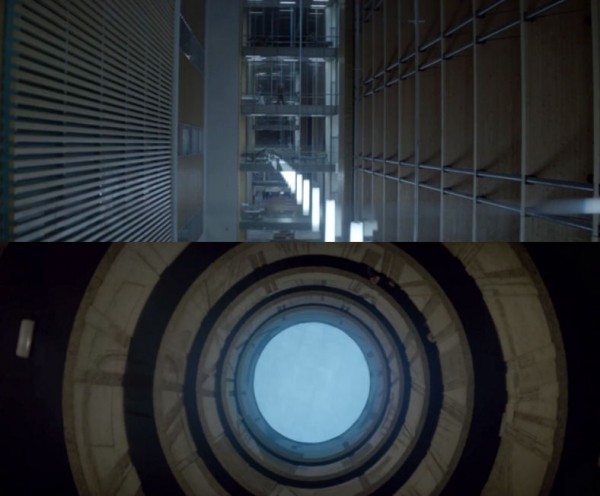
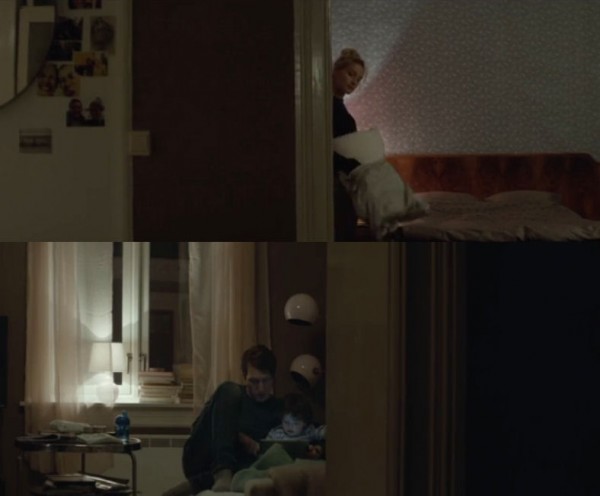

Charlotte is preparing to leave after one of the dance lessons in the film’s perhaps most stimulating visual and mysterious scene. At first sight it might seem like a brief flare-up of aestheticism without narrative importance, but it functions as a mood-laden and foreboding signal about the message she soon will get about her father’s death. Since the children for once are not to be seen, the situation is at the outset marked by emptiness:
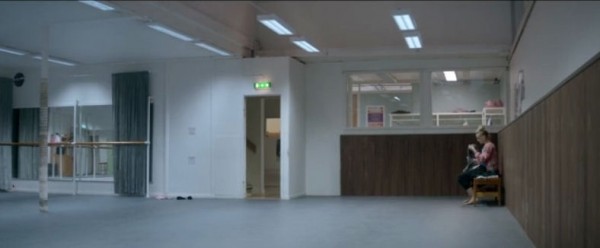

Swimming pools are another motif that meaningfully unifies the film. First the siblings play at the outdoor part of the hotel pool. Later we discover that there is a pool outside her mother’s house too; when Henrik and her son visit, they look out of the window and talk about how cold it would have been to swim in the pool now, in wintertime. In the new setting, this appears to be a visual reminder about the siblings’ taboo-breaking relationship:
During the funeral gathering we see Charlotte against the pool, as if in a visualisation of her yearning thoughts about meeting Henrik. Soon a decision is made, because in the next scene she turns up outside his house (also note the echoing repetition of the profile posture):
The film contains two embrace scenes where respectively Marte and her boyfriend look over Charlotte’s shoulder. Marte glimpses Henrik through the bathroom door just then, and this becomes another bit of circumstantial evidence in her suspicion about Charlotte’s incestuous relationship:
What Marte sees is not especially alarming in itself. The film is emphasising her gaze, however, as a signal to us that she has her suspicions, not without grounds. In an earlier scene Charlotte says that she is both afraid and that everything has fallen into place. She almost seems to be in love, strange since her boyfriend is gone and Henrik now seems to occupy a prominent place in her life. In the current scene it is in the middle of the day and none of the siblings are fully clothed. Charlotte’s behaviour is tense and peculiar, and she would like to see off her otherwise intimate friend Marte. Later Charlotte goes to pieces in the bathroom, after she has abruptly changed the subject upon Marte’s worried question about how things really are between Charlotte and Fredrik.
In the second embrace scene, after the dance performance, her boyfriend too is gazing over her shoulder – a sign that he is not particularly loving in this situation, but also the film’s signal to connect the two embraces and suggest that he too is suspecting something. It is natural to assume that after his return from the tour, Marte has informed him about the state of things. Just before the embrace he has received Charlotte with a strangely passive behaviour and a blank smile:
During a long pause after the embrace, where Sewitsky is stretching out time to make us really bask in that moment’s emotional nuances, it seems that both of them, without saying a word, realise that their relationship is over:
They bow their heads simultaneously in a dance of resignation, invoking the film’s many other situations with co-ordinated behaviour. Furthermore, Charlotte’s gaze in the first phase of the “dance” recalls her look at Henrik after she has returned his kiss in the film’s key moment:
The epilogue
The crying Charlotte wanders through the wintery city after her boyfriend has left her, to walk into summer as the epilogue starts. It is not only the season that signals a change of her state: her hairdo has been substituted with a more “grown-up” one with loose and longer hair. She is walking in the opposite direction. The camera dwells on a set-up with her face in profile, but contrary to the film’s many other profile shots of her, here she is in motion. Soon we learn that she has left the dancing school to become a student. Some of the film’s motifs are brought forward. Her studying is a copying of her mother’s favourite pastime; the intruder motif and the attachment issues return when she is introduced to a bunch of students who seem to know each other from before. Charlotte is still quite giggly in this situation, but she appears less insecure than before.
Thereafter follow a series of closures involving the most important characters. Charlotte is put in an awkward position on the local train when she stumbles upon Marte – with a newborn child and, unusually for her, in bright clothes. They probably meet for the first time since the break-up. Their encounter is far from unfriendly, merely embarrassing and sad. Sewitsky hits the exactly right notes: the former soulmates exchange banal pleasantries as if they were never more than remote acquaintances. Marte looks virtually transparent, like a ghost. Her tone of voice and behaviour are delivered in an almost mechanical version. Still her behaviour is easily recognisable, something that only makes the incident more saddening. Charlotte cannot get away fast enough.
Soon Charlotte arrives at the family house, from which her mother is moving out. Here the main part of the film is touched upon in various ways. We suddenly see that Charlotte wears the same shorts as so many times before. The video message via laptop with Oscar as the star is reminiscent of Henrik’s visit in the same house with his son. Charlotte’s embarrassment when the mother kisses her new boyfriend – the sudden intimacy with the “intruder” – recalls Marte’s protests when Charlotte’s kisses her brother during the wedding.
In this scene, however, there is a suggestion of change in the relationship between mother and daughter. After having been moved by seeing Oscar, the mother spontaneously strokes the cheek of a startled Charlotte. (Her surprise springs from the fact that her mother was unable to touch Charlotte when she was a child.)
Sewitsky is nevertheless carefully showing that the mother’s normal personality is still intact. It is suggested that she is the dominant part of the new relationship – she is loading her new man heavily with items when they carry stuff out – and we should not forget that even during her most self-centred behaviour before her dying husband, she also stroke his cheek, almost as if an automatic reaction:
Charlotte seizes the moment, however, to say that she loves her. The mother is moved in a way that is new to the film. She stammers that the emotion is mutual. Her embarrassment suggests that she thinks it is undeserved, mirroring Charlotte’s own insecurity about whether she deserves love from her surroundings. After the mother left Henrik, Charlotte represented a new start to her (“I was supposed to do it right with you”). May this new phase of her life turn into a new start for the mother-daughter relationship?
Charlotte offers to wait for Henrik, who is supposed to arrive soon to fetch things that Oscar shall have. The fact that these toys once belonged to Charlotte is a further, subtle building block in the film’s resonance. The box of teddy bears is very visible when they meet, connecting to the child/adult motif:
Via Marte on the train and Henrik’s arrival, the epilogue has in a short space allowed Charlotte to re-encounter both of her former soulmates. But after a cautious embrace (above), Charlotte seems determined that this meeting shall rise above mere politeness, and the film ends with a tentative, but apparently firm embrace.
Now we can yet again re-evaluate the opening shot. The statue also represents Henrik, who has been relegated to the background of Charlotte’s life, in a state of permanent powerlessness and despair after his mother left him as a child. Henrik has now entered the foreground, his bright clothes recalling the statue. The siblings’ copying of each other’s unnatural postures in the opening shot is transformed into a situation where they again repeat each other’s movement, but in a natural embrace. Distance has become closeness. Copying has become mutual harmony.
Even though the film definitively does not provide a clear-cut signal, in my view the embrace does not signal that the siblings again have given in to compulsive desire. Such an outcome would also be at odds with the epilogue’s general tone of cautious hope. The drawn curtains indeed cast some sort of secret, half-forbidden darkness over the scene. On the other hand they block the view of the swimming pool, the reminiscence of their romantic stay at the hotel. The point of the epilogue seems to be that she now dares embrace him, with no fear of the consequences, and that they – after all they have been through – are about to achieve a much more traditionally intimate and warm relationship than before.
The film music too supports this view. The harmonious-wistful synth theme of the “Cats” dance and after the break-up between the female friends, has now started for the third time (exactly when Charlotte says “I can wait here” to her mother). The theme is here transferred to Charlotte’s other soulmate, but brings with it the connection to a non-sexual friend relationship.
Precisely like it was important for Charlotte to say «I love you» to her mother before her childhood home was left behind, we now see the two siblings in an embrace of acceptance, inside the house where her brother once rang the doorbell as an 18-year-old. For a few moments, the brother and sister “live” inside the house to which Henrik never had access.
*



